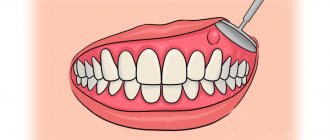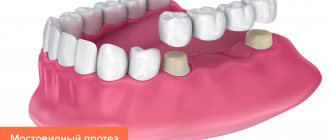The inflammatory process in the subgingival and subperiosteal jaw area with purulent formation (abscess) is called gumboil or periostitis. Its main cause is inflammation of the tooth root. A visual sign of the disease is a swollen cheek (a “bump” forms in the problem area).
Most of us prefer to treat flux on the gums at home, but periostitis is a fairly serious disease, the absence or untimely treatment of which poses a threat to the health of the entire body. In the article we will talk about the symptoms, causes of periostitis, and how to cure gumboil.
Flux: symptoms, causes of appearance
Characteristic symptoms of flux:
- swelling of the gums and face;
- pain in the area of the tooth that caused inflammation;
- enlargement and hardening of lymph nodes in the neck and head;
- general malaise: weakness, fever up to 38 degrees, headache.
Three stages of development of periostitis can be distinguished:
- at the first stage, pain occurs that bothers you when eating (due to contact with the site of inflammation);
- the gums swell, a “bump” appears, in which pus subsequently accumulates;
- swelling of various parts of the face (lips, cheeks, chin) occurs, the temperature may rise to 38 degrees, the pain radiates to the ear and visual organs.
The main reasons for the development of flux:
- advanced caries;
- complications after poorly performed treatment of pulpitis;
- gum injuries;
- hypothermia;
- jaw injuries;
- flux after tooth extraction;
- complications after flu or sore throat;
- inflammation of the gum pocket.
The following types of fluxes are distinguished:
- Ordinary. Pathogenic bacteria do not take part in the inflammatory process, but infiltration of the periosteum occurs.
- Fibrous. A chronic form of gumboil that develops as a result of exposure to irritants on the gum tissue. Thickening of the periosteum occurs.
- Purulent. It develops as a result of damage to the gums through which pathogenic bacteria penetrate. Often combined with purulent osteomyelitis.
- Ossifying. Develops as a result of prolonged irritating effects on the periosteum. Chronic illness.
- Serous. Periostitis with less pronounced symptoms develops quickly, but goes away within 2-3 days.
Why does pathological formation occur?
The main reason for the development of the pathological process is injury to the soft tissue of the gums. The disease also often develops against the background of:
- Caries.
- Inflammation of the gum pocket.
- Violation of the rules of oral hygiene.
- Infectious diseases: tonsillitis, furunculosis, etc.
Pathology is characterized by gradual development:
- The initial stage is characterized by the appearance of mild pain when touching the gums.
- In the second stage, swelling and redness of the gums develop, and the pain becomes intense.
- If left untreated, pus appears in the gum pocket, body temperature rises, and swelling spreads to the cheek.
- Next, an extensive inflammatory process develops, characterized by the appearance of acute throbbing pain and an increase in the area of edema. The patient's general condition deteriorates significantly.
Let's talk in more detail about the main types of fluxes.
Acute serous periostitis. As we wrote above, the inflammatory process occurs quickly and passes within a few days. It is characterized by severe swelling of the soft tissues. It is localized directly on the area with the diseased tooth, which is the main reason for the development of gumboil. The degree of inflammation depends on the structure of the vessels in the periosteum. The cause of the development of an acute form of serous flux can also be bruises and fractures. In this case, periostitis is called traumatic or post-traumatic. Most often it goes away on its own, but in some cases it can cause severe inflammation and the development of another type of flux - ossifying (fibrous growth).
Acute purulent periostitis. This type of gumboil is characterized by severe pain, which is often pulsating and spreads to the organs of vision and hearing, causing migraines. Pain is managed with medications and cold compresses. You should not heat the swelling site - this can lead to increased pain.
Purulent flux occurs with an increase in temperature to 37.5-38 degrees, the patient develops weakness and general malaise. It should be noted that the course of the disease depends on the location of the inflammation: in the lower jaw the process is more complicated.
The localization of inflammation depends on the location of the lesion:
- 1
Maxillary incisors - an inflammatory process on the upper lip and can spread to the nose. - 2
Maxillary canines and premolars - an inflammatory process in the periosteum.
- 3
Molars - an inflammatory process in the upper part of the cheeks.
- 4
Premolars - inflammation is localized in the lower part of the cheeks.
Chronic periostitis. The rarest form, which is usually localized in the periosteum of the lower jaw. In the chronic course of the disease, local inflammation is present, which does not change facial features. Characteristic symptoms are swelling in the mouth, enlargement of the periosteum, and lymph nodes. The development of this type of periostitis is a long process that takes from 4 to 8 months.
Swelling in the cheek area, causes
The most common dental causes of cheek swelling are:
- advanced caries;
- complication of pulpitis;
- complication of gingivitis;
- periostitis, periodontitis and other diseases of teeth and gums.
If you suspect flux, call: 8 (495) 558-88-77
Flux is inflammation of tissues of various origins, for example, periostitis, an inflammatory process in the periodontal gap - periodontium. Such inflammation can occur in acute and chronic forms; the chronic form can periodically enter an exacerbation phase and then subside again.
By origin, periostitis is as follows:
- infectious;
- non-infectious;
- spicy;
- chronic;
The main role in the development of flux of infectious origin belongs to microorganisms, as well as their toxins. Microbes penetrate into the periodontium through the root canal, periodontal pocket, as well as through the blood or lymph flow.
Most often, flux is caused by an infection that enters through the root canal and is a consequence of acute diffuse and chronic gangrenous pulpitis, as well as pulp necrosis.
Microorganisms and their toxins, penetrating into periodontal tissue, cause dangerous acute inflammation
Non-infectious periostitis/periodontitis (fluxes) can develop as a result of trauma (blow, bruise, periodontal trauma after pulp extirpation, sharp, uncomfortable biting on a tooth; cracking nuts, gnawing bones) or chronic microtrauma (smoking pipe, brass band instruments, biting threads, pressing on the tooth with a pencil, pen, etc.); also as a result of the influence of medications - the ingress of potent substances into the periodontium during the expansion of root canals (trilon B, aqua regia), their sterilization (formalin, silver nitrate, etc.) and in the ingestion of arsenic paste.
Flux diagnostics
The diagnosis of “periostitis” can only be made by a specialist. In order to identify the disease at an early stage, you will need to visit the dentist's office. Therefore, if such primary signs as hyperemia, accumulation of infiltrate, etc. are detected, we recommend immediately consulting a doctor for diagnosis. If an odontogenic type of periostitis develops in the mouth, then there is almost always a decayed tooth in the oral cavity, which is the cause of the pathogenic process.
Diagnosis is made using fluoroscopy. If the disease is in an acute stage, then it will not be possible to determine changes in the shape of the jaw using this research method, but it can be used to identify granulating periodontitis, which is a catalyst for the development of the inflammatory process.
How does soda work for flux?
Baking soda or sodium bicarbonate has an antiseptic effect. The beneficial properties of weak alkali make it possible to effectively use the substance when you need to soothe itching, normalize the acidity of the stomach, relieve the burning sensation of heartburn, and disinfect skin lesions.
Sodium bicarbonate is commonly used to whiten teeth and eliminate bad breath. At home, a solution of soda can relieve the inflammatory process and reduce gumboil, but to reliably eliminate the causes and prevent consequences, go to the dentist as soon as possible.
Tooth flux - what to do?
The most popular search on the Internet: “how to get rid of gumboil”, “how to remove gumboil from a tooth”, “removing gumboil at home”. If you detect even the slightest signs of flux, we recommend seeking help from a doctor. Flux on the cheek is a pathological process that requires mandatory treatment, which will avoid serious complications, including conditions that threaten the patient’s life.
If signs of flux suddenly appear, before consulting a doctor, you can perform procedures that will help reduce swelling. But they should be considered as a temporary remedy to alleviate the patient’s condition.
How to rinse with flux? The following solutions can be used to relieve pain:
- Alcohol tincture of calendula. A teaspoon of the product is mixed in a glass of water. The resulting solution is used to rinse the mouth.
- Infusion of green tea and sage. To do this, use a teaspoon of sage and green tea in a glass of water. The herb is poured with boiling water and infused for 20-30 minutes. You should regularly rinse your mouth with the resulting solution.
- Mint and lemon balm leaves. The herb is poured with boiling water and left for 3-4 hours. The resulting infusion is used to rinse the mouth.
Recommendations after opening the flux
When the first symptoms of flux development appear, you should not self-medicate. It is a mistake to believe that swelling and pain can be relieved with warm compresses, lotions based on herbal infusions or other folk remedies. Independent experiments aimed at combating flux can lead to complications.
It is important to remember that you should not take painkillers less than 3 hours before visiting the dentist. Otherwise, there will be problems with making a diagnosis. After the tooth flux has been exposed, you should not take aspirin, as it increases the risk of bleeding. If after 12 hours the condition has not improved, you should consult a doctor immediately.
Flux - treatment in a dental clinic
The choice of treatment method for flux depends on the type of periostitis, its severity, and the individual characteristics of the body. In the acute form, the nerve is removed, the wound is opened and cleaned, treated with antiseptics, and antibiotics are prescribed.
To defeat purulent flux in an adult, they resort to a more comprehensive treatment program. In this case, additional procedures may be prescribed, as well as complex antibiotic therapy.
Regardless of the type of periostitis (excluding the chronic form of flux), a mandatory step is a course of antibiotics, which is selected individually. As a rule, with the right course of treatment, the flux goes away within 7-10 days (stable positive dynamics of recovery are recorded on days 3-5). In the chronic course of the disease, the tooth after gumboil is usually removed.
Let us remind you once again that by refusing professional help, you risk your health. Without the participation of a doctor, there is a high probability of the formation of a gingival fistula, the penetration of pus into nearby tissues, which causes the development of phlegmon.
How to quickly get rid of gumboil at home: effective self-treatment methods
Periostitis or its popular name “flux” is an acute inflammatory disease that occurs as a result of a progressive infection in the tooth root.
This unpleasant disease is prone to rapid development and spread of damage to nearby tissues, as a result of which it is often accompanied by characteristic symptoms.
It is important to know that the inflammatory process can lead to abundant accumulation of pus, poisoning the body from the inside. That is why, at the first suspicion of flux, the patient should consult a doctor and begin to carry out therapeutic actions.
Typical signs
In most cases, the disease develops rapidly and is accompanied by pronounced symptoms. The inflammatory process begins with enlargement of the lymph nodes, pain during swallowing is possible, as well as severe swelling of the face.
Additional signs are:
- toothache while eating;
- redness and swelling of the gums;
- swelling of the neck tissue (occurs with advanced flux);
- headache;
- nausea;
- weakness;
- tachycardia;
- the formation of a so-called purulent lump;
- loss of appetite;
- pallor;
- increase in body temperature.
It should be remembered that the disease can occur in two forms: acute and chronic.
The first type develops quickly and is accompanied by an active inflammatory process. In just a couple of days, the patient may begin to suffer from severe facial swelling and high fever.
With chronic gumboil, symptoms develop more slowly, but despite the slowness, inflammation still continues to progress in the gum tissue.
Causes and provoking factors
Dentists pay attention to the following most common causes of flux formation in people:
- Mechanical damage to the oral cavity. This can happen due to a bruise or injury.
- Improper use of antiseptics during dental procedures (filling, tooth extraction, etc.), which led to infection in the tissue.
- Damage to teeth by caries that was not treated in a timely manner.
- Poorly installed filling or crown.
- Progression of periodontal disease and other dental diseases.
- Infection in the tissues of the oral cavity.
Is it possible to cure gumboil at home?
Let us immediately note that independent treatment can only be carried out under the supervision of the attending physician. Taking any action without the consent of a specialist can be extremely dangerous to the patient’s health.
Homemade recipes for periostitis have a pronounced anti-inflammatory and antibacterial effect. With their help you can reduce pain, relieve swelling and redness.
The most effective are:
- Mix a spoonful of baking soda in a glass of warm water until completely dissolved. Rinse your mouth with the product every two hours. You can also use sea salt instead of soda. This is the standard and most popular method.
- Get tea tree oil from the pharmacy. Blot the gauze with it and apply it to the inflamed gum. Leave for ten minutes, then rinse your mouth thoroughly with warm water.
- Soak a cotton pad in freshly squeezed onion juice. Add a spoonful of honey and the same amount of aloe juice. Apply to the gum for twenty minutes.
- Take a spoonful of chamomile, the same amount of oak bark and sage. Pour 0.5 liters of mixture. boiling water Leave for an hour. Use as a mouth rinse three times a day.
- Steam two tablespoons of nettle with a glass of boiling water. When the liquid has cooled, strain it and rinse your mouth with the product.
- Dilute aloe juice with water in a 1:1 ratio. Use for rinsing during active inflammation.
- Bake the onion and then apply it to the affected gum.
- Pour a spoonful of mint and the same amount of calendula into a glass of boiling water. Hold the liquid in your mouth for a couple of minutes.
Remember! You can use homemade medicinal solutions and tinctures only until a person develops a large accumulation of pus. In such a condition, treatment should only be surgical.
Medicines
Drug therapy for flux involves the use of the following drugs that have a pronounced antibacterial and antiseptic effect:
- Chlorhexidine. Dentists prescribe the drug to quickly eliminate germs and infections in general. It should be used for rinsing.
- Nimesil is used to eliminate pain. If necessary, it can also be replaced with Diazolin.
- If surgical intervention is necessary, the patient is recommended to prescribe Diclofenac.
- To remove pus, it is effective to use Vishnevsky ointment. You need to make local compresses with it.
- Furacilin. It has a powerful cleansing and antiseptic effect. It can be used both in the form of tablets and powder for rinsing. It is advisable to warm the finished product a little before use.
- Levomekol helps to restore tissue after pumping out pus.
In addition, traditional treatment, accompanied by severe inflammation and accumulation of pus, requires the mandatory prescription of antibiotics. They will speed up the healing process, eliminate infection and inflammation. For this purpose, it is best to use the drugs Amoxicillin, Lincomycin, Ciprofloxacin.
What not to do
In some cases, treatment without the supervision of a dentist is delayed for several weeks, as the patient practices the wrong therapy. The most dangerous actions that worsen the course of the disease are:
- Uncontrolled use of antibacterial drugs. If the medication or specific dosage is selected incorrectly, such an action will lead to the absence of the expected therapeutic effect and the development of a number of side effects (dysbacteriosis, abdominal pain, nausea, etc.).
- Delay treatment, in which the inflammatory process will spread to the entire oral cavity, which will significantly complicate further therapy and increase the likelihood of dangerous complications.
- Using warm compresses or heating pads. This is a very common mistake of patients, leading to increased inflammation and a sharp increase in body temperature. In this condition, doctors recommend limiting as much as possible any heat exposure to the affected area.
- Endure the pain.
- Try to pierce the gum gum yourself using sharp objects. Dentists consider this action a mistake, because in this case the patient risks not only infecting himself, but also causing heavy bleeding if the vessel is damaged.
- Use some folk remedies for treatment without first consulting a dentist. This action is dangerous because some folk recipes may involve the use of local or oral agents that will further intensify the inflammatory process (applications with garlic, mustard, etc.).
- Take analgesics before going to the dentist. They will significantly reduce pain, making it more difficult for a specialist to determine the degree of advanced disease.
Risks of complications
If the patient does not take any action, the disease will begin to develop further, which ultimately threatens the following complications:
| Complication name | Features of the course |
| Purulent periostitis | Accompanied by severe swelling of soft tissues and accumulation of pus in the cavity of the affected gum |
| Abscess | This condition leads to the spread of pus not only to the periosteum, but also to nearby tissues. This contributes to severe intoxication of the body |
| Phlegmon | Pathology leads to the penetration of pus into the tissues of the face and neck. This is a deadly disease that, without treatment, can lead to death. |
| Bleeding | Bleeding rarely occurs with flux, but if the inflammation is advanced, the risk of vascular damage increases significantly |
Remember! Treating complications is much more difficult than the primary disease itself. Fortunately, in most cases, patients can prevent the negative consequences of the disease by seeking medical help in a timely manner.
Preventive measures
To prevent flux formation, you must follow the following recommendations from doctors:
- Maintain oral hygiene. Therefore, you should brush your teeth and tongue twice a day.
- To remove food debris from your teeth, it is better to give preference to dental floss rather than traumatic toothpicks.
- Regularly rinse your mouth with antibacterial solutions.
- Enrich your diet with fresh vegetables, fruits, herbs, and nuts. Apples and carrots are considered especially useful in this regard, as they best contribute to the natural cleansing of teeth.
- Visit your dentist every six months for a checkup.
- Use a high-quality, medium-hard toothbrush; be sure to change it every three months.
- Eliminate any diseases of teeth and gums in a timely manner.
- Do not leave diseases such as caries and stomatitis untreated.
How to treat flux in a child?
Quite often, parents ignore the fact that they have baby teeth affected by caries, reassuring themselves that permanent teeth will soon grow in their place. However, an infected gum can cause gumboil to develop. The child’s body does not always react to periostitis with an elevated temperature, and the only symptom may be minor pain, which is not given any importance. The immunity of children is weaker than that of adults, so the disease progresses quickly.
In order to prevent complications, it is necessary to begin treatment at the first sign - clean the canal, close the hole in the tooth with a filling.
What to do if swelling appears after treatment at the dentist
If after tooth extraction your cheek is swollen from the tooth, there is no need to worry - this is a normal reaction. You can take a pain reliever that your dentist recommends. When a pathological condition is accompanied by pain and weakness, the temperature should be measured.
Edema does not always indicate a complication; it is worth distinguishing a simple reaction of the body from a pathological condition. Don't worry if:
- the flux disappears 3 days after surgery;
- the swelling is not pronounced and does not increase in size;
- no temperature or it does not exceed 37.5 degrees;
- the pain is aching, slight, gradually goes away, eliminated with analgesics;
- in the hole there is a bloody dense clot, which is covered with fibrous tissue within 2-3 days.
On a note! Do not apply hot lotions to the injured area, release pus yourself, or massage the gums. This will provoke further development of the infection, which will lead to serious consequences.
The following symptoms indicate complications:
- the flux grows;
- there is severe pain that cannot be relieved with analgesics;
- tension together with surgery;
- temperature over 37.5-37.6 degrees;
- it hurts to swallow, speak, open your mouth;
- there is no blood clot in the hole or it is covered with a green, gray or yellow coating;
- unpleasant odor from the mouth;
- itching, hyperemia, shortness of breath - indicate an allergic reaction.
Attention! If you have any of the symptoms, you should consult your doctor. Such signs indicate infection. If an operation was performed, the treatment is carried out by a dental surgeon or an endodontist if the root canals were cleaned.
FAQ:
How to rinse the flux to make it break out?
As we wrote above, any procedures cannot replace consultation and treatment in a dental clinic. Before visiting a doctor, in order to alleviate the condition and reduce swelling (edema), you can rinse your mouth with various antiseptic and antimicrobial agents, for example, chlorhexidine. Additionally, you can use sodium saline solution, sage decoction, and calendula tincture.
The flux has burst - what to do?
If the flux has burst, the time before visiting the doctor can be used to carry out simple procedures on your own. First of all, you should rinse your mouth with clean water at room temperature. You can do this using a soda solution - to do this, you need to dissolve a teaspoon of soda in a glass of warm clean water. It is advisable not to eat before being examined by a doctor.
What to do to prevent flux?
The best prevention of flux is regular hygiene procedures in the oral cavity and timely treatment of foci of chronic infection.
Do not forget that gumboil may not go away on its own, turning into a chronic disease, and given that it poses a serious danger to human health, we recommend that you do not hesitate to contact a dental clinic. Only here is reliable diagnosis and effective treatment possible. Be healthy!
Rules for using flux soda
Soda helps relieve pain and reduce swelling, sometimes it is possible to completely get rid of the gumboil, but the reason for its appearance will remain and sooner or later everything will happen again. It will not be possible to solve the problem without a dentist, so do not delay your visit. In the meantime, please note a few rules:
- Do not prepare the baking soda solution ahead of time. A portion should be used during one procedure, then the alkali loses its beneficial properties.
- It is advisable to use solutions rather than applications so that the soda powder does not burn the mucous membrane.
- Do not increase the concentration of the solution - the therapeutic effect will not become greater.
- The temperature of the solution should be about 20-22 oC.
- Try not to drink or eat for at least 40-60 minutes so that the substance has time to take effect.
Take care of your teeth
Contraindications
There are practically no contraindications to the use of sodium bicarbonate, but only if the dosages and rules of use are observed. In some cases, soda is contraindicated:
- Young children cannot rinse their mouths on their own. There is a risk that the child will swallow the solution, and this is undesirable.
- If you have been to the dentist and your gums have been cut or a tooth has been removed, you do not need to rinse your mouth with baking soda. The lye will soften the blood clot protecting the wound, and bleeding may begin.
- You can rinse several times a day, but the interval between procedures should not be less than two hours. With more frequent use, the mucous membrane will dry out.
- Stomach ulcer is another contraindication. In this case, getting soda into the stomach is extremely undesirable.
- Sodium bicarbonate rinses should not be used if you have a soda allergy or diabetes.
We hope our recommendations will be useful, and if necessary, you will ease your suffering before going to the dentist. Tell us about your experience and don't forget to like it.











